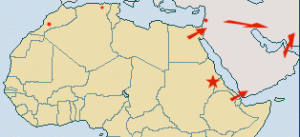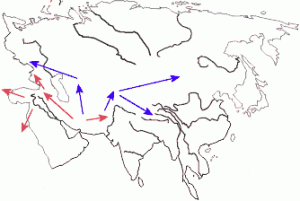Cosmic Order and Cosmic Anxiety
Cory Panshin on December 9, 2010If the last ice age did coincide with the earliest and most traumatic “romantic break” — when faith in the transformative-and-kinship partnership was shattered and the dance of the visions truly began — then the period between 70,000 and 10,000 years ago must have witnessed the active development of not only the spirit vision but also a number of other alternatives.
In particular, the successor to the transformative vision — cosmic order — would have been undergoing a burst of intense speculation.
We are all familiar with the cosmic order vision from its final stages, when a conviction that society should reflect the mathematical elegance of the heavens gave rise to the great civilizations of Egypt and Sumeria, India and China, Central America and Peru.
But the earliest intimations of that vision, which must go back almost to the dawn of modern humanity, involved no such grand ambitions. At the very start, there were only a few lonely science geeks who had begun tracking the movements of the sun and moon and were awe-struck by their regularity.
Certain aspects of those observations appear to have been incorporated into the older visions even before cosmic order itself was fully defined. In the transformative vision, the Moon was seen as female because its monthly phases so closely matched the cycle of women’s menstruation. And when the transformative-and-kinship partnership was established, the pairing of Sun and Moon became a central expression of the fundamental male-female duality.
The spirit vision would have been even more closely attuned to the first suggestions of cosmic order. Shamans are often described in archaic societies as traveling to the Moon in trance or as drawing their spiritual energy from the skies.
But for those individuals who were devoted entirely to the new vision, the heavenly bodies were not merely secondary reflections of human sexuality or shamanistic power. The pure scientific wonder they aroused would have been akin to what the early 20th century poet Edna St. Vincent Millay meant when she wrote, “Euclid alone has looked on beauty bare.”
It appears that every vision starts off in much the same way, as a loosely organized assortment of meaningful personal experiences, theoretical speculations, and mystical flashes. But at a certain moment, it crystallizes into a tightly focused vision of human possibility, taking on both greater definition and a wider appeal.
That was what happened to the holism vision in the late 1930’s, when it moved beyond the realm of environmental science and abstract philosophy and began to inspire projects like the abortive Frank Lloyd Wright scheme in which my in-laws participated. And for cosmic order, the same transition is likely to have involved a belief that humans could and should emulate the perfect balance of the heavens.
If we can rely on the recent visions as a guide, that crystallization would have taken place around the time the transformative-and-kinship partnership was reaching its peak — say roughly 100,000 years ago.
 The initial recognition of cosmic order is likely to have been strongest in northern Africa and the Middle East. In the tropics, where modern humans originated, the seasons are not clearly tied to the movements of the sun. But as you go further north, it becomes obvious that cold weather arrives as the days become shorter and the sun moves lower in the southern sky — and that the return of the sun also means the return of warmth and fertility.
The initial recognition of cosmic order is likely to have been strongest in northern Africa and the Middle East. In the tropics, where modern humans originated, the seasons are not clearly tied to the movements of the sun. But as you go further north, it becomes obvious that cold weather arrives as the days become shorter and the sun moves lower in the southern sky — and that the return of the sun also means the return of warmth and fertility.
This seeming ability of the heavens to control affairs on earth would have been a powerful metaphor for the imperative to follow the dictates of one’s own higher nature. But with the onset of a new ice age, the bond between heaven and earth was broken.
At that point, the sun still returned, but it no longer brought summer with it. And as the cold grew increasingly acute and the expansion of the deserts severed the bonds of kinship that had united far-flung communities, the sense of desperation must have been almost unbearable.
The physical and psychological impact of the ice age would have fallen most heavily on the people who were barely clinging to survival in the Middle East, as compared with those back in Africa or in the tropics of Southeast Asia. But the area of the Persian Gulf, which was then dry land, appears to have offered a welcoming refuge, and by 50,000 years ago a crucial technological advance — the sophisticated stone-working techniques known as the Aurignacian — had appeared in the Zagros Mountains, on the northern side of the Gulf.
 By then, the grip of the ice age had started easing off a bit, and during the so called interstadial period which followed, bearers of this new technology were able to expand in all directions — westward to Europe and North Africa, eastward to India, and north into the grasslands of Central Asia and Siberia.
By then, the grip of the ice age had started easing off a bit, and during the so called interstadial period which followed, bearers of this new technology were able to expand in all directions — westward to Europe and North Africa, eastward to India, and north into the grasslands of Central Asia and Siberia.
It was not merely technology which powered this expansion, however, but also a new set of beliefs, forged in the crucible of the great cold. For those who survived that devastating experience, it would have been essential to have an understanding of existence which both explained their present situation and provided them with assurances as to the future. And the primary source of that understanding would have been the emerging cosmic order vision.
Beliefs cannot be dug up out of the ground in pristine form like stone tools, so it is impossible to know exactly how cosmic order was understood 50,000 years ago. But there are two attitudes reflected in the myths and religions of later times which appear likely to have been based in the experiences of the ice age.
One is a fear that things will keep getting worse and worse. That the cold will intensify, human life will be destroyed, the sun itself will fall from the sky, and all of existence will end in an apocalyptic smashup.
The other is a belief in a lost Golden Age of peace and abundance — coupled with a hope that such a time may yet return.
These two attitudes are not mutually exclusive. In the Norse myth of Ragnarök, for example, the coming of endless winter is followed by the disappearance of the sun, moon, and stars, the destruction of mankind, the death of the gods, and finally the burning of both heavens and earth. But out of the burning, the earth rises again from the sea, green and fertile. The children of the gods return, the daughter of the sun follows her mother’s path, and two surviving humans emerge from hiding to repopulate the earth.
That particular myth, with its gods and multiple heavens, reflects the elaborate cosmology that was a product of the final stages of the cosmic order vision. It could not have been conceived during the ice age, any more than Asimov’s Foundation stories could have been written in the 17th century, when the science vision was first crystallizing.
But on the other hand, the 1600’s did give rise to a wave of whimsical accounts of journeys to the moon, which combined the new Copernican astronomy with satirical reflections upon society. This genre of lunar voyages, which gradually became less scientific and more satirical and died out in the early 1700’s, is in some ways closer in spirit to modern science fiction than anything else prior to the scientific romances of the late 19th century.
In much the same way, the central themes of later myths — both the fear of utter destruction and the hope of renewal and rebirth — may have made their first appearance in rudimentary form during the ice age. And if that is so, the great wave of expansion from the Middle East may have been powered by a dream of reclaiming the Golden Age.
Dreams of that sort have repeatedly inspired waves of migration in more recent times. The Puritans who settled chilly New England, for example, were able to persevere and eventually flourish, where earlier commercial ventures had failed, because they were fortified by their religious and utopian ideals.
So perhaps the pioneers who settled the great Eurasian grasslands — which were rich in game but bitterly cold — may have believed they were discovering a land of unfailing abundance, like that which rises from the sea at the end of the myth of Ragnarök.
As those pioneers adapted to their new territories, they produced a series of extraordinary inventions, such as bone and ivory needles to sew snug winter clothing, that enabled them to survive even when the extreme cold returned around 30,000 years ago. By then, they were both physically and mentally prepared for it — and the great visionary art of the deep caves, which was produced at the very peak of the final glaciation, is a testiment to their faith and their resilience.
Eventually, the ice age came to an end, and there was a great forgetting of how things once had been. All that remained was a persistent sense of cosmic insecurity that was passed down from generation to generation and attached to whatever new threats of disaster might appear. The rapid rise of sea levels as the ice sheets melted, for example, generated a wave of flood stories which recast the old themes of destruction and renewal in updated form.
Even today, some 1500 years after the final collapse of the cosmic order vision, we continue to scan the skies for portents of disaster. And our politics, as well, remain dominated by fears of decay and corruption on one hand and hopes of renewal on the other. Such is the enduring power of the metaphors built into the visions, even when the visions themselves have long since passed the era of their original dominance.
Related:
A listing of all my posts on deep prehistory can be found here.
A general overview of the areas of interest covered at this blog can be found here.
A chronological listing of all entries at this blog, with brief descriptions, can be found here.
Read the Previous Entry: And So It BeginsRead the Next Entry: Among the Spirits




